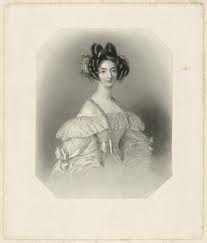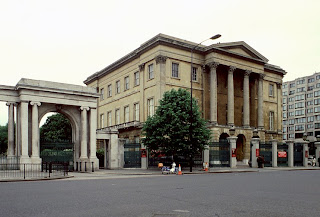The first quadrille was danced at Almack’s – pictured are the Marquis of Worcester, Lady Jersey, Claronald Macdonald and Lady Worcester.
The Duke of Wellington’s ties to the Marquis and Lady Worcester were fastened on both sides – Lord Worcester had served as an aide-de-camp to the Duke of Wellington during the Peninsular War, while the Marchioness of Worcester, Georgina Frederica, was the daughter of the Hon. Henry Fitzroy and the Duke’s sister, Lady Anne, and therefore Wellington’s niece. Prior to their marriage, Lady Shelly wrote in her diary, “Georgiana Fitzroy’s marriage was announced. It was to take place on the following Monday, when the Duke was to give her away. I hope that it will turn out well, but I have my doubts! Lord Worcester is only twenty-one, and very wild.”
The marriage proved happy enough but, at the age of 28, Georgina became gravely ill. The following account is from The Letter Bag of Lady Elizabeth Spencer-Stanhope – ” . . . Lady Worcester was not expected to live thro’ last night. She was at the Birthday and at the ball, danced a great deal, felt unwell, and was fool enough to take a shower bath before she went to bed. She was seized with inflammation in her bowels and in great danger immediately. Lady Worcester’s sufferings were most extreme, her complaint a twisting of the guts. She died sensible but screaming. On one side of the bed sat Lady E. Vernon, on the other, Lady Jersey, also screaming with grief. The Duke of Wellington had to drag them by force out of the room. There were eighty people standing round when she died.”
Apsley House
Mrs. Arbuthnot’s Journal gives us another view of the events leading up to Lady Worcester’s death:
“Lady Worcester died after a week’s illness of inflammation brought on by going into a cold bath after dancing at the ball at Carlton House. She was only 28, one of the handsomest women in England, had made the most brilliant marriage and was flattered, followed and admired by all the world. It is sad to contrast all this brilliancy with the cold and dreary grave that will so soon close over her; and yet she will then have more tranquility, for her prospects were not happy ones. Lord Worcester, overwhelmed with debts, had lately had executions in his house and, if the Duke of Wellington had not given her rooms in his house, she would not have had a hole to put her head into. . . . .
The New Monthly Magazine ran the following report about her death on May 11, 1821 — At Apsley House, the Marchioness of Worcester, of an internal inflammation. Her Ladyship was Georgiana Frederica Fitzroy, eldest daughter of the late Hon. Henry Fitzroy, son of Charles, first Lord Southampton, brother of the Duke of Grafton, by Lady Anne Wellesley, sister of the Duke of Wellington and Marquis Wellesley; and was married to the Marquis of Worcester on the 25th of July, 1814. Her Ladyship was one of the most intimate and favourite friends of the late Princess Charlotte.
And from the Greville Diary – May 12th.—I have suffered the severest pain I ever had in my life by the death of Lady Worcester. I loved her like a sister, and I have lost one of the few persons in the world who cared for me, and whose affection and friendship serve to make life valuable to me. She has been cut off in the prime of her life and in the bloom of her beauty, and so suddenly too. Seven days ago she was at a ball at Court, and she is now no more. She died like a heroine, full of cheerfulness and courage to the last. She has been snatched from life at a time when she was becoming every day more fit to live, for her mind, her temper, and her understanding were gradually and rapidly improving; she had faults, but her mind was not vicious, and her defects may be ascribed to her education and to the actual state of the society in which she lived. Her virtues were inherent in her character; every day developed them more and more, and they were such as to make the happiness of all who lived with her and to captivate the affection of all who really knew her. I have never lost anyone I loved before, and though I know the grief I now feel will soon subside (for so the laws of nature have ordained), long, long will it be before I forget her, or before my mind loses the lively impression of her virtues and of our mutual friendship.
“This is one of those melancholy events in life to which the mind cannot for a long time reconcile or accustom itself. I saw her so short a time ago ‘ glittering like the morning star, full of life and splendour and joy;’ the accents of her voice still so vibrate in my ear that I cannot believe I shall never see her again. What a subject for contemplation and for moralising! What reflections crowd into the mind!
“Dr. Hume told me once he had witnessed many death beds, but he had never seen anything like the fortitude and resignation displayed by her. She died in his arms, and without pain. As life ebbed away her countenance changed, and when at length she ceased to breathe, a beautiful and tranquil smile settled upon her face.”
 |
Emily, Duchess of Beaufort |
As stated above, Lady Worcester died on 11 May 1821, and on 29 June 1822, her husband Lord Worcester married Lady Anne’s other daughter, Emily Frances. This opens up a whole can of worms, as it was against the law for a widow or widower to marry a brother or sister-in-law. How did they get around this? It might have been due to the fact that Emily had been Lady Worcester’s half sister – their mother, Lady Anne’s husband, Henry Fitzroy died on the 19 March 1794, and on 2 August 1799 Lady Anne was remarried to Charles Culling Smith. Their daughter Emily Frances Smith was born on the 3 March 1800. Regardless, the Duke of Wellington was not happy with the match, which caused a rift between himself and his sister.
On 23 November, 1835 Emily became the Duchess of Beaufort. She died on 2 October 1889 at age 89 and was buried at Badminton. Her mother, Lady Anne Smith, died in 1844.

